#cochin rooster
Explore tagged Tumblr posts
Text
Behold: Jimmy Two-Toes

He's called that because he's missing two toes
#Cochin#cochin rooster#chicken#cute#rooster#chick#hen#bird#poultry#fowl#photography#my chickens#nature#pet#pets#handsome
5 notes
·
View notes
Text
Chickens likely domesticated themselves the same way wolves did which is basically by hanging around our settlements and eating our refuse.
Living with chickens in this sort of way was likely happening way before the estimated times of 8,000- 10,000 years ago. The relationship was likely already long established it was just during that time some chickens started developing smaller/weaker adrenal glands which caused them to become much easier to raise and handle which eventually lead to the domesticated chicken we know of today (and how that happened so suddenly is a completely different but very interesting topic)
Also due to this you could argue that there isn't any true wild red jungle fowl left untouched and uninfluenced by humans anymore. Not only due to constant cross breeding with domestic chickens but because red jungle fowl are still doing what their ancestors did in their current range, if there is a town or village nearby the bravest junglefowl will still choose to intermingle with the village and eat the refuse, agricultural byproducts, and waste. People will still catch and care for these "wild" birds like their ancestors did. This isn't to say we shouldn't try our best to preserve the wild red jungle fowls wild genetics, their should be populations left to be in their natural environment but it's likely they are not truly same wild birds they once were thousands of years ago and honestly that's OK because thats how its been for thousands of years.
#basically domestic chickens suddenly became so wide spread so suddenly those thousands of years ago because a chinese ruler was like#i need to feed my people and im going to use these birds to do it#so they selected for big birds who were calm so they wouldnt freak out and burn calories#and they selected for less rooster to rooster aggression so they could house large amounts of birds together#and those birds were basically proto cochins#also game birds are very simialr to wild jungle fowl since their adrenals are physically different then asiatic breeds and their derivatives#they like have their own things going on im not getting into right now but#its all very cool and fascinating#also by learning this i learned that a lot of the older breeders in america think that like chicken breeds just#came unto existence via god??#Christian fundamentalism is wild
239 notes
·
View notes
Text

I interrupted his salad feast just to scoop him
38 notes
·
View notes
Text




Nubs and Cochin in the nest bucket
#bantam#chickens#poultry#cochin bantam#old english bantam#black breasted red old english game bantam#partridge cochin#cutest little couple#hen#rooster
0 notes
Text


Quintessential chicken owning experience is collecting hatching eggs from ur mixed flock for some guy. Tell him u dont want payment. Guy brings a baby rooster and two hens from his bantam cochin breeding to trade instead.
81 notes
·
View notes
Note
Hi! 😁 I might soon have the chance to have a garden and I've always wanted to have a few chickens, and I've started some online reasearch about keeping chickens but since you're an expert and I don't trust some of the online sources, do you have any tips for absolute beginners? 😅
I do! You can have a garden, or you can have chickens, but the two are diametrically opposed forces that do not coexist peacefully without fully enclosing one or the other. Chickens can and will obliterate gardens and landscaping if they have access to it, including absolutely destroying mulch patches by helping you spread it all over the yard.
I'll put the rest under a cut ^_^
When you acquire chickens, don't get them from a hatchery, get them from a small breeder you've looked into and spoken with about their actual birds. Hatcheries have poor quality animals, so while you may be getting a "black copper marans," they're not gonna necessarily look very nice, and they're almost certainly not going to lay that nice, deep chocolate marans are known for.
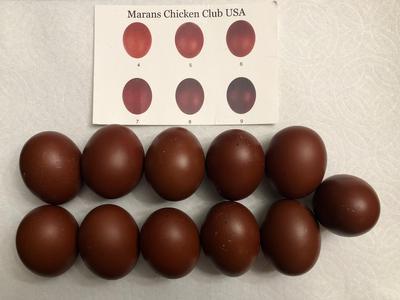
Vs straight from one of the bigger hatcheries pages, photos of their eggs:
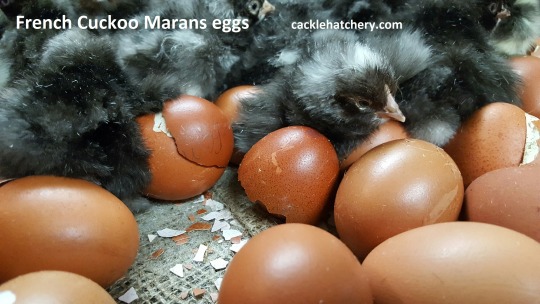
You also are NOT going to get the breed qualities of any given breed except maybe some of the production breeds. For example, a Jersey Giant from a reputable breeder will get up to 10-13lbs, which is as big or bigger than my peafowl. Same with Brahmas and Cochins. Hatchery stock you will be lucky to see 6-8lbs, and people are OFTEN disappointed about this kind of thing. Silkies, as another example, can look WILDLY different from a hatchery vs a private breeder. A show quality silkie is a puffball:
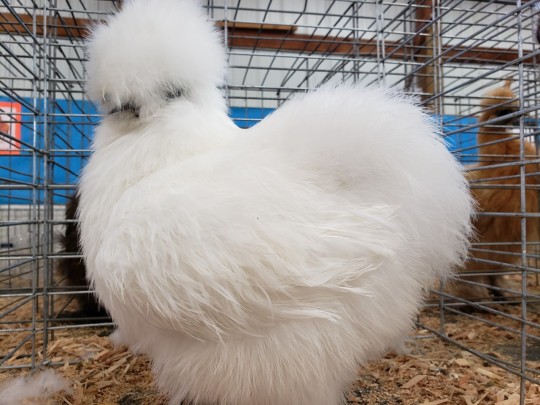
Hatcheries also pull skeevy moves like calling easter eggers (mutts that lay blue, green, pink, brown, or white eggs) "americanas" hoping that you mistake it for "ameraucana" the pure breed that lays stark blue eggs. Then they charge you ameraucana prices (like, $25/chick) when they should be charging more like $3-5 a chick. They'll do things like call a marans/barred rock mix a "mystic marans" as if it's a new color morph of a marans chicken instead of a mixed breed mutt they invented to be able to sex their chicks at hatch easier. People get these guys expecting MARANS eggs, and they get tan barred rock eggs. Same can go for temperament and behaviors. You go anywhere that has a group of chicken owners and ask them what their favorite breed is, you will get a range of answers with reasons like "my X is so sweet" while the next person will go "mine's the devil" and if you ask, 9 times out of 10, it's hatchery stock birds. Well bred private breeders often have MUCH more stable temperaments.
vs hatchery stock
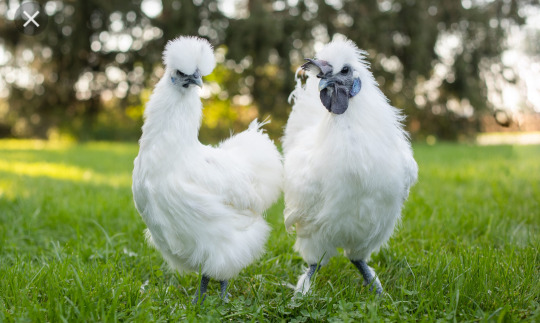
Getting from a private breeder also lets you get eggs, which can help you dodge a LOT of disease bullets. There's very little that transfers through the egg, strangely, and some of that is transferred on the surface of the eggs (like mycoplasma) so a quick santizing dip before incubation gets rid of that. I know that hatching them yourself is more of a hassle, but so is losing your flock to newcomers that came in with something entirely avoidable if you'd hatched instead. If your breeder is NPIP certified, they're getting tested for the major egg-traveling problem (pullorum) and a dip will take care of most anything else unless you're super SUPER unlucky.
Lastly on acquisitions, be prepared to get roosters. If you can't have roosters, be prepared to get them processed for yourself for food, or let the roosters go to food homes. Please please please please. There are so many, many excess roosters. They cannot all go to homes. The rooster to hen ratio in a flock is like 1:9. The rooster to hen ratio in hatching is nearly 1:1. Let someone make use of them. EVEN if you order from a hatchery, and order all pullets, they can make mistakes and send rooster babies. It's not a guarantee! Have a plan in advance! Mentally prepare yourself! Don't be one of Those People making posts in local groups about how you don't want/can't have this rooster but also no one else can eat it either. Chickens are a lot of things. Sometimes food is one of those things.
BEFORE actually acquiring the chickens, locate a vet that will see them. You are GOING to have an issue at some point in their lives, and that's not the time to start looking for a vet, that's the time to already have a vet on hand. In fact if you can support a yearly wellness check on at least one of the birds to test for communicable illnesses (like mycoplasma) and have a good relationship with your vet in advance, that's even better.
As for care, if you plan to contain the chickens, the minimum recommendation for a backyard coop and run varies wildly. For stress purposes, most chickens will find 4 feet of floor space per bird inside the coop adequate, accompanied by 10 square feet of space in a run per bird. Unlike peafowl, it doesn't matter how big the run is, the chickens will be turning the entire thing to bare soil, which is one of the reasons most people don't keep both in the same pens. I literally attempted to keep 2 standard chickens in a 1200 foot pen and they systematically went about destroying everything they could get to.
Most layer feeds are 16% protein; most layer feeds are also /production/ layer feeds, meant to feed production breeds in a space where they get NO other feed except this. If you plan to feed anything other than layer feed to them, like treats or whole foods or scratch grains, then you need to find a higher protein feed for them, because most treats are lower protein than layer feed. Avoid anything produced by Purina or Dumor (which is purina but TSC brand), except MAYBE the organic dumor 5-grain scratch grain, it's well-known as one of the worst quality fowl feeds out there. Check out your local mill and see if they have any options that are better than the big box farm stores. Kalmbach makes good feeds, as does Belstra.
Possibly counterintuitive, but stick with a smaller waterer over a larger waterer. You can keep a larger one around for if you go away for the weekend or something to make it easier on a sitter, but a smaller waterer like a 5-quart or gallon waterer will be easier to clean and make sure that you're giving fresh water more often, plus avoiding mosquitoes growing in it. Waterers can slime up really easily in the summer, so just be prepared to give it a quick swish clean every time you change the water out. Smaller waterers also make it easier to give them medication if you have something that goes in the water, especially since a lot of the water medications are "make fresh daily." Personally I don't bother with heated water bases anymore in the winter, I just have enough waterers to exchange them for a fresh one a couple times daily, while the old one thaws inside the back door on some plastic. The galvanized ones you have to use with the heated bases always got gross fast, with rust and discoloration and the stopper in the bottom always dried out and eventually cracked over the summer when we weren't using them.
Try to avoid straw bedding unless you REALLY trust the source. Straw is mostly for livestock, not poultry. It cannot catch the droppings of poultry the way shavings or sand or other beddings do, meaning the wet gunk drops to the floor under it and/or collects into grossness. It also molds easily, can carry in field parasites (since it's not treated the way shavings are often kiln fired before packaging), and breaks down into shards. I'm not saying you can't ever use it for any reason (I use it in some fashion, and have for over a decade, but not exclusively, and I trust my source, we've never gotten mites or anything, and I'm very careful about which bales I pick out), but if you have a choice, go for the wood substrates, or even for sand. A lot of people put sand in their runs because they can then rake it like kitty litter.
Look into what plants chickens can't have, and check your yard over thoroughly for them before adding chickens. Things like lilac bushes are toxic to them. Tomato and potato plants are nightshades so while they can have the fruits, the leaves and stems can be toxic. Stuff like that.
Lastly.... if anyone ever makes a claim about what something does for a chicken (example: diatomaceous earth, apple cider vinegar, pumpkin seeds, oregano, red pepper flakes, lavender, etc are all things I've seen people claim do all sorts of things from worming birds to curing respiratory infections), ask them for their source. If it's a blog post, ask them for a scientific article. If they can't provide it and you can't find one that backs up what they're saying, maybe reconsider the value of that particular advice. The thing is, the BIG production companies are VERY invested in finding cheap or organic or tricky ways to do WHATEVER it is (treat endo/ectoparasites, treat illness, make bigger or more eggs, change egg yolk color, etc), and they pour money into trying to figure out which old wives tales actually work and which ones don't. And if they haven't been able to prove it to a point where they'll spend money on it as a solution, then chances are REALLY GOOD that it's not a solution at all actually.
Things like how to clean coops, what feeds to get, what items to use for care, where to source birds, behavioral information etc, that's all stuff you can ask advice on in general public spaces. You'll still get a range of answers, and some of them will be garbage answers, but hardly any of them will do harm to your animals to do or not do. Like, for example, you can use a big waterer or a small waterer, as long as it's clean. You can vary coop and run size and still be fine. You don't have to feed exactly what someone else is feeding for your birds to be fine. You're probably going to try a few breeds before you find the one(s) you like best.
But when it comes to medical info or any kind of "treatment" type stuff? Consult a vet and/or at least look for scientific papers.
And lastly.... chicken math is Real, yo. However many chickens you think you want to get, plan on having the space for double that amount so you don't gotta rebuild anything when you ultimately decide wait, you need a couple more. The bigger space won't hurt them if you don't get more, but it'll be so much easier on you if you do ;)
227 notes
·
View notes
Text

I wasn't going to talk about this, [because it's sad] but I think it will come up anyway for the sake of transparency and my Ko-fi.
I have chickens. We've had them for several years. We don't eat them, they all have names. They just roam the property during the day and eat the lawn down and give us eggs. Two years ago we lost half our flock because someones bastard dog entered our yard and just... slaughtered them. Ran them down for fun and killed ten of our hens. Our roosters fought back because that's their job. Rooster spurs function like raptor claws and they will jump kick anything they don't like. One of our roosters barely survived the attack. He lost a tennis ball sized hunk of flesh from his rear and back and was recovering in the house for months. He's a fully black, part Cochin named Tipsy. Our calmest quietest boy.
The day before yesterday something attacked our flock again. The neighbors [who all have dogs] say they've been seeing coyotes. We had six roosters to protect the flock. Tipsy is the only one who survived. This time with lost feathers but no bites. Pictured is our original alpha Whisper. He died in the coop, likely protecting the others. We lost several girls; Cookie, Sarah, Dominique. I'm still trying to take stock. They killed Songbird, Robin, Yang and Red. The reminder is a dozen hens plus Tipsy. Lie is devastated. She cried all day and through her shift. So I did something impulsive that I really couldn't afford for her sake. I ordered some chicks. They're usually between $3-6 each when they're only a day old. I got six females. Nothing special or expensive. And they threw in a free one which will almost certainly be a rooster of some random breed. Just to give Tipsy a second in command. So in about three weeks I will likely have chick pictures to share and that will be the reason. I hate seeing my love so sad. And we've bowed out on getting chicks the last two springs because of money or time issues. Now I just need to clear out the storage space for the pen and set up the lights and junk again.
Also someone sent me a pair of trailcams and I don't know who it was. Thank you. ;_; So if I get any good ghost or animal photos you'll get to see those too. We're just recovering here.
42 notes
·
View notes
Text
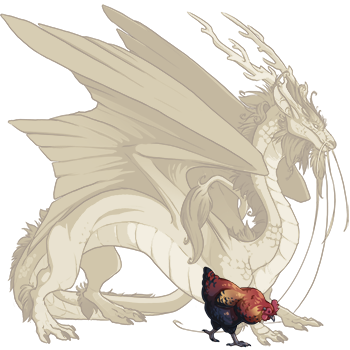
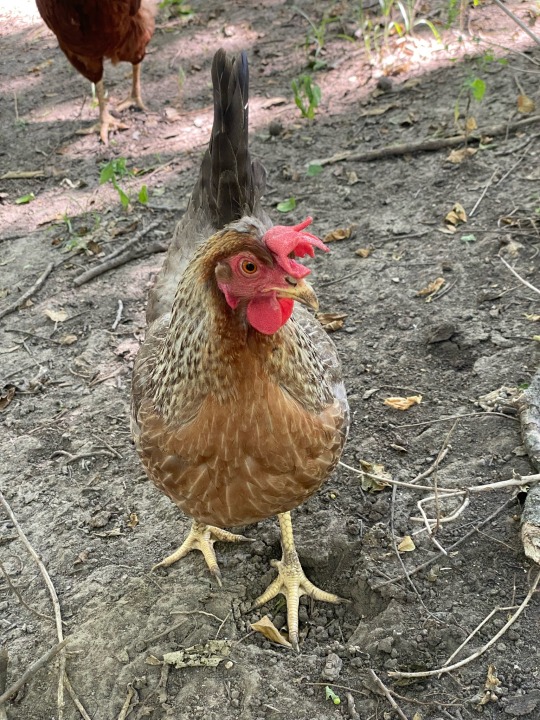

For the chicken thing, here’s FR’s welsummer (now just named rooster) vs my hen vs the internet’s rooster. Yeah, it has the rooster coloring, and yeah it doesn’t have a rooster’s saddle feathers or spurs, but like. I’ll let you in on a secret. Chickens are super diverse in sexual dimorphism. There are hens who crow and grow saddle feathers and roosters who look like hens. Nature is funky. I’m honestly just glad staff picked endangered and unique breeds (Brahma and Cochin- though they are recovering, and Sebrights who the livestock conservancy org considers critical)
It’s not perfect, but like. What is man. And chicken owners should know that chickens are messy

Bonus of one of our broody hens :]
44 notes
·
View notes
Text

Landshaker
She/Her
Female
Adoptive mother
Straight (but is very open)
Very large
Cochin Chicken Rex
Pale blue eyes
Landshaker is Landslides adoptive mother. She is a massive T-Rex with the similarities and plumage of a Cochin Chicken, but she is far from a wuss. She acts as fierce and aggressive as a rooster would, but more than triple the size. She is a strong Rex momma, takes no back or bad talk behind her back. Say it to her face if you’re ballsy enough.
Overall a very good mother and a ruthless Rex.
7 notes
·
View notes
Note
Sorry if this in invasive or anything, but can I see your chickens?
YES YOU MAY




The rooster is a Silkie named Moe. He is very awkward but very sweet. He tries to feed Taylor, the light brown one, and always lets her eat first. He desperately wants to be a good provider for her, and when I give him treats he often runs to her and drops them at her feet. He calls her when he finds food, but unfortunately she stopped coming to his calls because he keeps trying to feed her rocks. He is not smart but he has the heart. Sometimes he barks.
Taylor, the light brown one, is half Frizzle half... Cochin? Maybe? I'm not sure what her father is. But her mother is the white one in the last picture. She is very trusting of me and uses me as a jungle gym, jumping on my arms, lap and shoulders when she can. However she has a weird hand fixation and I cannot be within her line of sight without gloves or she will race to me fast as she can with the sole purpose of biting the fuck out of my hands. I do not know why she does this. It is targeted. She will jump up to bite me if I am standing up and out of her reach. Why.
Fluffypants, the white one, is a Frizzle. She is Taylor's mother, and is also Moe's nemesis. She is in timeout because she really, REALLY wants to know what his corpse looks like. She also loves to scream like she's dying for no reason, she is fine. She just wants attention immediately. She is very soft but a bit skittish when it comes to being held. I'm training her to be less skittish about it.
8 notes
·
View notes
Text
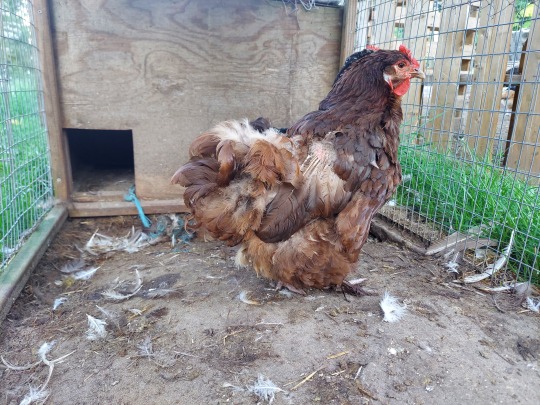
AHHHHH! CHOCOLATE LARGE FOWL COCHIN! GRAIL CHICKEN ACHIEVED!
She needs a molt.
ALSO i picked up that buff laced wyandotte rooster. I'mma make funky things with him next year!!!!!!
#I sold ... three rabbits for these chickens#basically tradesies#and now I get to sell off basically all of my bantam cochin#except my lavender project because that's the next lf goal#well that and the buff laced yknow
4 notes
·
View notes
Note
I really want to get the chickens in my breeding project to be larger. Do you have any tips for how to breed chickens for size while also maintaining good health? I am doing lots of research but it also helps to be able to get direct advice.
Rule of thumb is outcrossing will get you bigger chickens while inbreeding will get you smaller so always keep that in mind, those initial outcrossed might not pass on their size but they will be bigger if your looking for bigger for meat purposes.
It would help to know what breed your trying to increase in size since some breeds are better for outcrossing with each other since they are either are already present in the breeds ancestry or are closely related due to where they were created regionally.
For example some Cochins and Brahmas are extremely similar, only real difference is the pea comb, brahma face, and different color varieties. If you have a Cochin and you wanted them to be huge then I would suggest using brahmas and breeding out the pea comb and brahma face to increase size.
For me that would look like a cochin rooster over some big cochins girls i like as my foundation and some brahmas of the same or similar color. I would breed them then keep back the babies who were healthiest, the right size and type i want, and the correct color in that order.
Then you would breed those babies together and with their parents always choosing the healthiest and biggest babies at the end. You might want to band the babies that are most promising so you can compare them to their siblings to see if they really end up bigger. Don't choose your birds as chicks, wait for them to grow out first.
If you want to miminimize inbreeding depression I suggest clan breeding it is the best way to keep up genetic diversity if you have enough space.
Things to keep in mind when breeding big chickens
- They need good strong hearts, wait for a bird to make it past their first birthday before breeding them.
-They need thick strong legs to hold their weight and safety land from high places.
-The legs should have good angles, legs that are to straight will cause pain and arthritis.
-Good feet, breeding stock shouldn't be prone to bumble foot and overgrown nails. Birds who are should be removed from breeding pen.
-For healthy joints and bones they shouldn't grow rapidly, there is a reason the giant breeds take almost a year to fully mature sometimes more.
-Bigger chickens are more dangerous, do not allow aggression or man fighters in your breeding flock.
8 notes
·
View notes
Text
Fuck being nice. I just want to be an angry little bantam cochin rooster that actively chooses violence.
3 notes
·
View notes
Text
I have cochins. They're super chill and often broody if you want to hatch your own chicks. And a rooster with Brahma blood diluted with something else. [He has the color but only a slightly above average size.] I also have barred rocks with are the same if not super similar to the Plymouth Rocks.
The closest I've come to the ayam cemani [which I think is beautiful] is my witch OC Dawn Razor who has one as a familiar.

This is.....niche. Do period-appropriate chickens even still exist? Idk anything about chickens. I like the fancy ones.
85K notes
·
View notes
Text
Good news and sad news on the farm.
I can tell the orpington egg from the mauve cochin egg from the barred and blue cochin eggs (but not the barred from the blue) from the sussex eggs. So if i can figure out that blue from the barred, in which case i need all three hens to lay on one day, then i don't need to separate those hens and flip the rooster at all! Woo!
I did end up having to kill Sinner, though. His spine is straight and intact, and there is no indicator to his problem internally. Except he smelled rank as soon as the abdomen was open. I can't find his liver (though i forgot to look again after i rifled through the stomach).... It's fucking weird. Poor boy barely lifted his head today. I gave him lots of snuggles before I put him out of his misery. His song is also stuck in my head. Really banking on his babies....
2 notes
·
View notes
Note
Hey, I was wondering what separates high-quality birds from low-quality birds? I saw the term on the bantam comparison post, and I get the general idea, but every time I try to search it more specifically, it just gives me raw chicken.
A high quality bird is going to typically be overall a "better" bird then a low quality one and that can be different things for different breeds. For example in America we like our Ayam Cemani to be nice and shiny when in Indonesia they like their black to be dull and "darker" and some breeders actually select birds who have poor feather quality as an aesthetic. In that case those birds would look low quality to us but would be high quality to them. But i can still give my personal opinion on what makes a bird high quality.
A high quality chicken will have these traits
-Closely matches their breed standard or the historic traits of the breed. That means the birds shape, feather color and type, and personality all fit their breed.
-Great health, longer lived and a longer productive life meaning hens lay longer and roosters stay spunky for longer.
-Great feather quality, feathers are correctly shaped for their breed,sturdy, and dont wear down quickly.
- Colors have depth and richness to them. They should be uniform with no interuptions in the feather and patterns and transitions should be clean
-Good personality. The birds should be handable and good mannered even naturally skittish breeds should be worked with to improve that
You get the above with careful selection, breeding the right birds together and sourcing good foundational birds who fit the above criteria. A farm mutt can be high quality if its from good breeding and care in my opinion.
Hatchery quality or Low quality birds are birds typically bred under the idea that quantity is better then quality. Typically these birds will have the opposite traits to those i listed above.
Beeper for example is hatchery quality lets compare her to her breed standard and a bird id consider high quality, the bird on the left is Beeper and the one of the right is a Champion

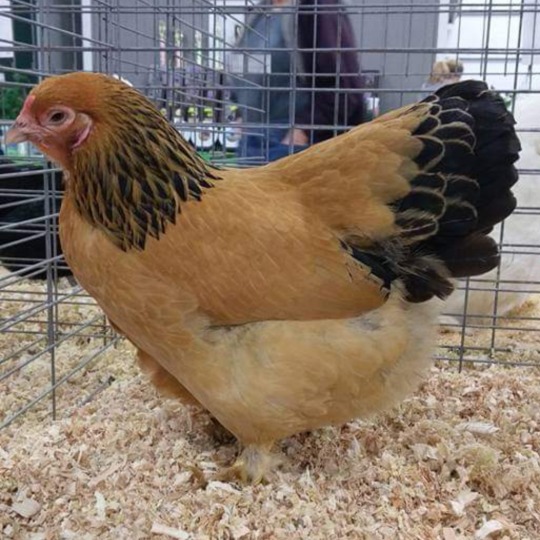
Here is an illustration of a dark bantam brahma from the America standard of perfection from the 1950s. Keep in mind the hen on the right above could angle her neck like the picture below, her head is just more relaxed.

Here is what the standards want and say is most important, ill pick out the things that pertain to Beeper specifically. Im using the australian open poultry standards for my source.
-The head and crown are most important breed characteristics. Texture of the feathers is also of great importance, for the plumage should be smooth fitting and not loose- feathered and soft as in the Cochin.
-The head is small, rather short, of medium breadth, and with slight prominence over the eyes. Beak short and strong. Eyes large and prominent. Comb triple (or "pea"), small, closely fitting and drooping behind. Face smooth, free from feathers or hairs. Earlobes long and fine, free from feathers. Wattles small, fine, and rounded, free from feathers.
-Comb, Face, Earlobes and Wattles should be bright red.
-The Body should be broad, square, and deep; full breast, with horizontal keel; short back, either flat or slightly hollow between the shoulders, the saddle rising half-way between the hackle and the tail until it reaches the tail coverts ; medium-sized wings with lower line horizontal, free from twisted or slipped feathers, well tucked under the saddle feathers, which should be of ample length; tail of medium length, rising from the line of the saddle and carried nearly upright, the quill feathers well spread, the coverts broad and abundant, well curved, and almost covering the quill feathers
With those standards i have listed and the the comparsions i have shown i want you to make your own judgements (like your a poultry judge) on why Beeper isnt the same quality as the hen on the right.
(Also i want to say sometimes these comparisons hurt peoples feelings for some reason. I love Beeper her not being the best quality doesnt make me love her any less lol)
52 notes
·
View notes